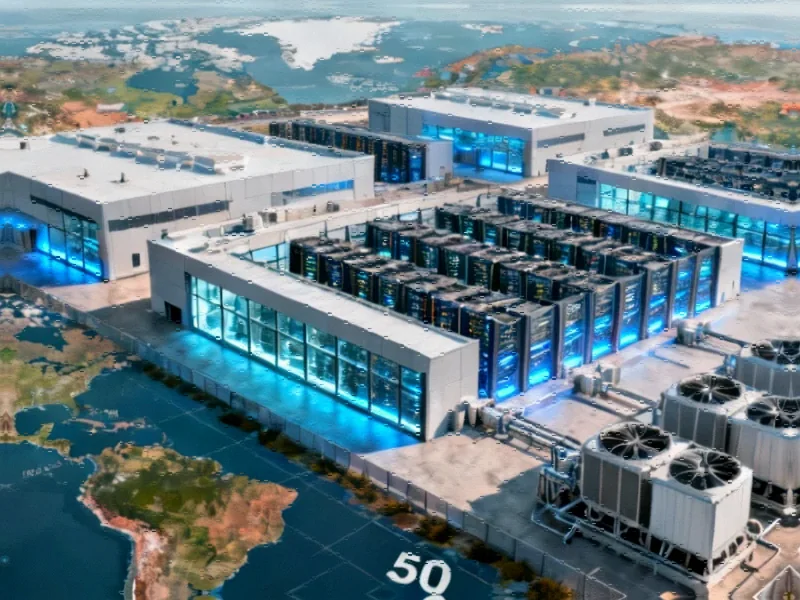According to DCD, Lincoln Property Company has reacquired a 191,000-square-foot data center at 2500 W. Frye Road in Chandler, Arizona, marking the second time the company has owned this specific facility. The 28MW data center sits on 14.5 acres and features four data center halls, with one currently leased to a Fortune 500 enterprise user. Lincoln plans to fit out the remaining three halls to add 16MW of capacity and transition the facility from evaporative-cooled to air-cooled mechanical systems, targeting initial 4.2MW delivery in early Q1 2026. The company previously owned the property in 2018-2019 before selling it to CBRE for $72.7 million, and the site has approval for additional development including a potential 243,000-square-foot building. This strategic move comes as Lincoln’s data center strategy evolves to meet unprecedented demand in the Phoenix market.
Arizona’s Unprecedented Data Center Demand
The Phoenix metropolitan area has emerged as one of North America’s fastest-growing data center markets, driven by several key factors that Lincoln’s executives clearly recognize. Arizona offers abundant land, relatively low electricity costs compared to coastal markets, and a favorable business climate that has attracted major hyperscale operators including Google, Microsoft, and Meta. The state’s dry climate provides natural cooling advantages, while its geographic position makes it ideal for serving both West Coast and growing Southwest populations. What makes this particular acquisition strategic is the immediate availability of utility power through the existing Salt River Project substation – a critical advantage in a market where power procurement delays have become a major bottleneck for new development.
The Strategic Value of Reacquisition
Lincoln’s decision to repurchase a facility it previously owned and operated represents a sophisticated real estate strategy that offers multiple advantages. The company brings institutional knowledge of the property’s physical infrastructure, mechanical systems, and operational history that outside buyers would lack. This familiarity reduces due diligence time and costs while enabling more accurate projections for renovation timelines and budgets. The fact that Lincoln sold this asset to CBRE in 2019 at what appears to have been a favorable price point, only to repurchase it during a period of extreme market tightness, suggests strong strategic timing. The company’s leadership clearly understands the cyclical nature of data center real estate and has positioned itself to capitalize on both acquisition and disposition opportunities at optimal moments.
Mechanical System Transition Implications
The planned transition from evaporative-cooled to air-cooled mechanical systems represents a significant operational shift with important implications for both sustainability and reliability. Air-cooled systems typically use more electricity but significantly less water – a critical consideration in Arizona’s drought-prone environment. This move aligns with growing pressure on data center operators to reduce water consumption, particularly in Western states facing water scarcity challenges. According to EPA WaterSense data, data centers can consume millions of gallons of water annually for cooling purposes. The transition also reflects evolving industry standards where air-cooled systems have become more efficient and cost-effective for certain power densities and climate conditions, though the capital expenditure required for such conversions can be substantial.
Shifting Competitive Dynamics
This acquisition strengthens Lincoln’s position in a market where available powered-shell capacity has become increasingly scarce. The Chandler submarket has emerged as a particular hotspot, with major players including Equinix, Digital Realty, and CyrusOne operating significant facilities in the area. Lincoln’s ability to deliver 4.2MW of turnkey capacity by early 2026 positions it to capture demand from hyperscale users who need immediate capacity but face long lead times for greenfield development. The facility’s existing Fortune 500 tenant provides immediate cash flow while the remaining halls offer development upside. This combination of stabilized income and development potential creates a balanced risk profile that should appeal to both the company and its capital partners.
Market Outlook and Future Implications
The Phoenix data center market appears poised for continued strong growth, though several challenges loom on the horizon. Power availability remains a constraint, with utility providers like Salt River Project and Arizona Public Service managing increasingly complex interconnection queues. Water usage concerns could lead to additional regulatory scrutiny, particularly for facilities using evaporative cooling systems. The market’s rapid expansion has also created labor shortages for specialized data center construction and operations talent. Lincoln’s strategic repositioning of this facility suggests confidence that demand will continue to outpace supply in the medium term, particularly for well-located assets with existing power infrastructure. As more enterprises pursue digital transformation and cloud migration strategies, facilities like this Chandler data center will remain in high demand despite broader economic uncertainties.




